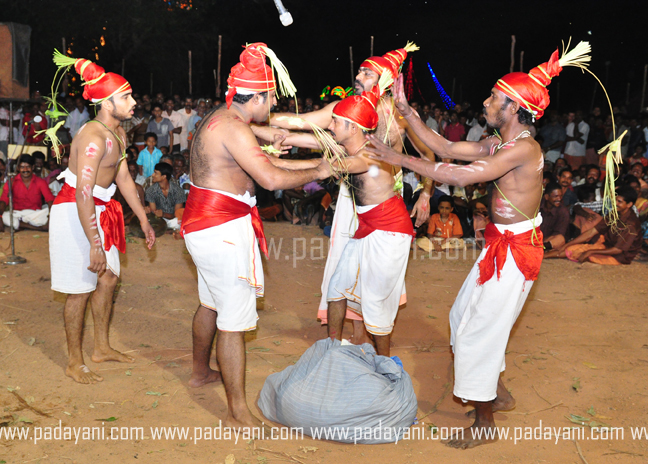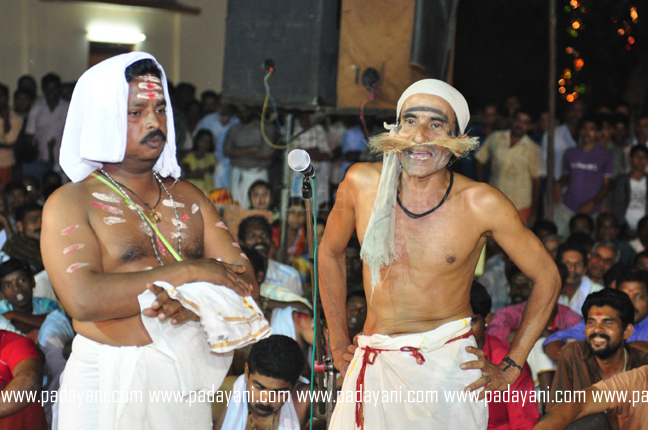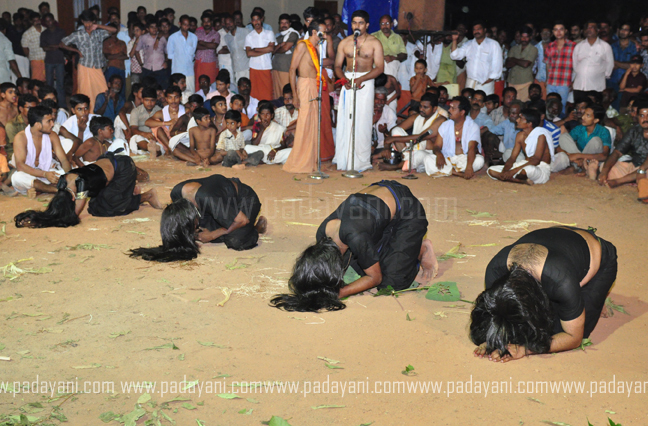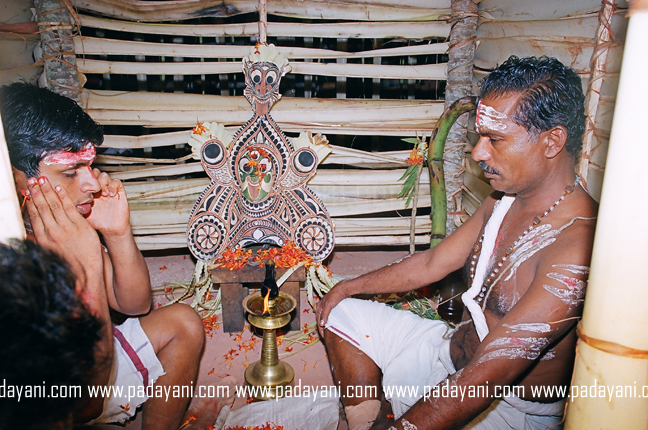Drama (Vinodam)
Folk art forms have been inevitable and contributed markedly in the history of world theatre. In Kerala, the drama and theatre was motivated by various ritualistic and folk performances. The Malayalam drama Almarattam(The Disguise) written in 1866, based on a Shakespeare play, is considered to be the first of its kind. The musical plays performed by artists from Tamilnadu were eagerly watched by the Kerala People. Before all these, Central Travencore Malayalees had witnessed full fledged theatre performance, drama and skits performed each year as part of the Padayani festival. Till now its been performed in the full form only in Kurampala. In other places its been cut short during the lapse of time. At present, only 23 plays are being performed. Its believed that there were more plays but the ancient playwrights may not have thought of the coming generations. So only 23 are available.
Comedy parts in Padayani reflects its commitment to society. They include satire and criticism to social evils. Padayani targets all the 64 races of then existed society of kerala. These comedy parts are staged in different forms as drama, mono acts, dialogue, dances etc.
Velichappadu
Velichappadu reaches stage as the mouthpiece of Devi. Holding false sword in hand and adorning false chilampu on leg, wearing red silk on the waist and head, velichappadu addresses the viewers. The whole body is covered with ash and sandal paste. His parables and attempts to drive away badha often arise laughter in the audience.
Paradeshi(Foreigner)

In an age lacking press or electronic media news were brought to the villages through Paradeshis’ . They are supposed to be constant travelers bringing news from all the world around. In addition to news they share philosophical thoughts with common people. They are experts in reciting slokas, singing songs and performing differents forms of dances. This entertainment includes the dialogue between the villages and paradeshi and various artistic performances of paradeshi. Head is covered with a red silk which is rolled in to the form of jada( thick inseparable mass of hair). From this konta( artificially made jada) there hung bits of kuruthola, kuruthola birds, and kuruthola serpents etc. These adornments are attributed to Shivajada, sivaganga waterbirds and flowers of Ganga. Admirations of lord Shiva and lord Krishna are often sung. Songs of paradeshi comprise of pathinjapattu (slow), Murukiyapattu (fast), kummi, Deshakkummi etc. On certain days of padayani Kuttiparadeshy (child) , Vellapparadeshi (white dress) are also staged.
Pulavritham
This is deeply related to farming activities. Hand-body movements in this dance form also reflect such activities. Pulayar with pointed hats of arecas dry leaf sheath, wearing torn decoloured clothe piece reach the kalam. From their dialogues and speeches we get a vivid picture of the ancient society Deities once worshipped under trees by pulayas and like races were later transferred to temples and worshipped with new concepts by so called civilized society. Pulaya awfully criticises these concepts and shower satirical remarks on such rituals and belief. Six, eight or ten performers perform dances resembling sowing, transplantation, loosening of soil, harvesting, paddy processing, driving away of chaff etc. in a circle. Main lyric of Pulavritham tell the story of incarnation of Bhadrakali and Darikavadham. Kuruvikkatha (story of swallow), Ramayana, Nalacharitham, birth of Vyasa are also sung along with the former one.
Kuravarkali
Dressing style is similar to that in Pulavritham. It is a group performance of six or eight artists. This entertainment is otherwise called kampukali or kumbhamidichupattu. Bambu rods of varying length are vertically hit on flat stone to produce humkara sound. With this rhythm, artists make leg movements in a circular fashion. Rods are beaten each other. This also offer a rhythm. Ramakatha (Story of lord Rama) in a Tamil slang is sung for kuravarkali.
Namputhiriyum Valyakkaranum

It is one of the most interesting comedy item of padayani. Nampoothiri’s speech is explained and interpreted by the servant in his own way. This explanations and interpretations are very humorous and arise laughter in the audience, Nampoothiri appears in the kalam with one neriyathu on the head and the other hanging on left hand and of course with a holly thread. The servant wear a decoloured clothe piece. A husk moustache is also his speciality.
Sharkkarakkudam
This satirical performance targets the vanities of be bureaucracy. A merchant dealing in jaggery and a servant porter with the jaggery pot on his head are the main characters of this entertainment. With white dhothi tied around the belly, ornaments on the ears and sandal paste dot on the forehead the merchant reaches the stage.
Anthoni
This is a one man show. Only an expert can succeed as Anthoni. He himself has to act as Anthoni, the boatman and characters like Nampoothiri, Foolish Konginippattar, Drunkard, Kuravan, an old lady performing thiruvathirakali, her modestful grand daughter etc.
Ammoommayum Appooppanum
An old lady comes in search of an old man who wedded her for the second time. Grey head, walking stick and two hanging clothe bags in place of breasts are her features. Towards end the old man also appears on the stage.
Masappadi and Pravarthyar
Theme of the entertainment is corruption of the Govt. servants. Masappadi is a Govt. servant entrusted to collect tax from the public and remit the same to govt. Pravarthyar assesses the tax due of each person based on his income. Masappadi and Pravarthyar went to a lady selling toddy to collect tax arrear. Experiences that they receive there are humorously described here.
Kunjarikka Maharshi
Ugly face, Arecanut suspended from the head, one side of the moustache painted red, other black, dhothi- these are the features of Kunjarikka maharshi. This character reaches with specific footsteps behind a white clothe screen drawn spread by two persons. He does not do any work to earn his livelihood. He leads a parasitic, luxurious life. He feeds himself on the feast prepared in other houses during special occasions. His speech is full of blunders like his experience in massaging godly beauties, his participation in war between Deva and Asura and on. This character leaves the stage singing kali kaala varnana.
Pattarum Kalyaniyum
A foolish Tamil brahmin, with a cloth bag on the shoulder and a fan made of dry areca leaf sheath in the right hand comes to the stage, followed by a girl with dancing steps. As the pattar failed to get a girl from the native place, he went to Panti (Tamilnadu) and bought a girl. Fooleries of Pattar are humorously described here.
Ashanum Sishyarum(Teacher and Students, Oottupattar, Balippattar
Story of an ashan( teacher) and his naughty followers is described in Ashanum Sishyarum. Oottupattar depicts a Tamil brahmin with unbearable greed for eatables. Balippattar describes the experience of a person approaching a Nampoothiri to perform sacrificial offerings.
Chakka
A few persons hanging coconut leaf baskets (vallam), balls made of coconut leaves, from the waist appear the kalam. Their aim is to drive away thieves from cashew plantation. Along with the rhythm of kaimani made from areca leaf sheath, their waists are moved forward, backward and sideways. This is called sarvangathalam in padayani.
Thangalum Padayum
A Muslim gentleman reaches the kalam, seated himself in the hands of two persons. There are a group of warriors holding shield and stick in hands, around thangal. Thangal tells the story of his marriage. A deferent style Thangalum padayum Performing at Ezhumattoor padayani
Mudiyattom, Kurathy

Men disguised in female robes perform this art with face panted black, heads covered with wigs of long locks of artificial hair. Wearing black brassiere and black dhothi, artists perform dances in tune with songs admiring hill deities. As the dance progresses, locks of hair get untied and whirl in the air in a rhythmic way. Kurathi also has the same robe pattern. Kannum kuriyum, protruded teeth, sword in the right hand, lighted torch (Pantham) in left hand are some additions. It is fearful in sight Vigorous steps are taken by ‘Kurathy’. When the performance becomes uncontrollable, kuravan appears the ‘kalam’ and take back sword and torch from kurathi’s hands by force. Kurathi now continues to dance in tune with mudiyattappattu with untied hairlock.
Seetanagan Thullal
This entertainment is staged on the Adavi day. Head covered with a black cloth as if it resembles a slanty hair mass. From this konta woven kuruthola are hung. Seethangan has shoulder bangles made of kuruthola. Black Dhothi, Kachamani are other features of seethankan. Dance begins after explaining the birth of paraya race.
Pooppada(Kaniyan Purappadu)
A girl possessed by a Gandharva is seated there in the kalam, holding a arecanut bunch. ‘Piniyal’ does not do ritualisting dance. To seek the reason for this unusual happening kaniyan is brought there. The remaining part of the entertainment is about the fooleries done by the ignorant ‘kaniyan’
Vairavi
A humorous character appears on Adavi day. If the public do not honor him with alms, he would commit suicide cutting himself. This is the warning of vairavi.
Kakkalan
To perform this role, an actor requires masterly skill. Black dhothi, moustache of peacock feather, body painted black, dotted forehead with lime paste, a bar holding cloth bag on the shoulder are the features of kakkalan. This character reaches the kalam singing various vaytharies ( oral musical exercises). This item includes the dialogue between the audience and the kakkalan and his songs and dances.
Ambalavum Vilakkum

A temple model is made of Vazhappindi. Installation if idol, rituals, hoisting of ceremonial flag and like temple activities are humorously imitated. This actually targets the Aryanization of worship. Originally idols of Gods were placed under trees and worship was done in a simple natural way. Later this mode of worship was overthrown by Aryan god concepts. As in social life, the Nampoothiris established a supremacy on the very religious life of common people. Protest of common people is reflected in Ambalavum Vilakkum. This item is seen only in Kurampala padayani. A model of jeevatha, used for parayeduppu, is made. Holding it on the shoulder, with vigorous dancing steps, temple model is totally destroyed in the end.


